Dunfermline and District Tramways
History
After a number of abortive schemes for an electric tramway between the towns of Dunfermline and Cowdenbeath, powers were finally granted on the 21st December 1906 under the Dunfermline and District Tramways Confirmation Act (1906); the act also incorporated a new company — the Dunfermline and District Tramways Company — which would build and operate the tramway. A key player in the promotion of the act was the Edinburgh-based electric engineering concern, Bruce Peebles and Company Limited, which had just finished construction of the local power station, owned by the Fife Electric Power Company, from which the tramway would purchase electricity. The newly formed tramways company was controlled by BP&Co, via another newly registered company — the Fife Syndicate Limited — in which the well-known tramway contractors, J G White and Company, were also a major shareholder.
Here matters rested for the next three years, presumably because the necessary financing could not be arranged, uncertainty around the construction of the nearby Rosyth Royal Navy base almost certainly playing a role in this. This all changed in 1909 when Balfour-Beatty and Company acquired control of the tramway company, around the same time as construction of the nearby Royal Navy base was announced. In a complex series of financial moves, BB&Co not only took control of the tramway company, but also the Fife Electric Power Company, both of these being placed under the control of another BB&Co subsidiary, the Fife Tramway Light and Power Company Limited (formed on the 3rd July 1909).
Construction of the 3ft 6ins-gauge overhead electric tramway began on the 16th August 1909, with the first portion of the main line — from East Port in Dunfermline to a temporary terminus at Moss Side Road in Cowdenbeath — opening eleven weeks later on the 2nd November 1909. This was followed the next day by the branch in Dunfermline to Townhill, and on the 23rd December 1909, by an eastwards extension from Cowdenbeath to Lochgelly. The initial services were operated by 20 tramcars.
The company was clearly focused on the future shape of the system, and with this in mind, powers for further extensions were obtained on the 26th July 1910 — under the Dunfermline and District Tramways (Extensions) Confirmation Act (1910)— even though several lines authorised by the original act were as yet unbuilt. One of these was the branch northwards from Cowdenbeath to Kelty, which was opened on the 17th November 1910; due to severe mining subsidence, much of it was laid on sleepers to enable ease of maintenance. Four additional tramcars were obtained to work the extra mileage.
Given the late start on tramway construction (1909), the company could not complete the remaining lines within the stipulated timeframe, so had to seek an extension to the time allowed, this being granted on the 18th August 1911 under the Dunfermline and District Tramways Order Confirmation Act (1911). An extension of the main line from Lochgelly to Lochore was opened on the 5th December 1912, and from Dunfermline to Rumblingwell on the 27th December 1913; four new tramcars were acquired to supplement the existing fleet.
On the 19th September 1914, the tramway had its first exposure to unregulated bus competition, when vehicles of the Autocar Bus Company began competing for passengers between Dunfermline and Kelty. The outbreak of war brought about a hurried application for powers that included a line out to the naval base at Rosyth, which was still under construction; these were duly granted on the 29th July 1915 under the Dunfermline and District Tramways (Extensions) Order Confirmation Act (1915). The line was, however, held up by disagreements over the precise course of the tramway, or rather, the new road on which it would be built, such that it only opened three years later on 17th May 1918. Such was the importance of the base, or rather the projected importance, as it was not fully completed until 1920, that the tramway company was allowed to procure four new tramcars in 1918, a rare occurrence during the conflict.
Like many tramways during the Great War, the D&DT was placed under immense pressure, not only losing skilled men to the armed forces, with a consequent reduction in maintenance, but it also had to carry greatly increased numbers of passengers. The tramway was, however, fortunate in that its infrastructure was, relatively speaking, quite new, so the excess traffic and reduced maintenance did not have quite as dramatic an impact as elsewhere.
After the war, the company acquired two second-hand tramcars from the Nottinghamshire and Derbyshire Tramways Company (another BB&Co subsidiary), and set about a program of track replacement and doubling that would continue throughout the 1920s. Yet another extension to the time allowed for construction of authorised lines was required in 1920, this being granted on the 4th August 1920 under the Dunfermline and District Tramways Order Confirmation Act (1920).
The tramway was dealt two blows in 1922, firstly, by the announcement that the naval base would be placed on 'care and maintenance', and secondly, by the appearance of significant motorbus competition on the main line, which readily extracted passengers from the overcrowded trams, not least because of the high fares. The tramway company, which was highly profitable, was much criticised for its high fares, and eventually responded to the bus competition by lowering them; it also increased the frequency of tramcar services, and introduced its own motorbus services on the 3rd April 1924, under powers it held in the 1906 act. Despite the competition, and the full closure of the Pembroke and Rosyth Docks (announced in 1925), the company continued to be profitable.
In December 1925, the company's motorbuses were placed under the management of the larger Scottish General Omnibus Company, which was controlled by its parent company, the FTL&PCo. Despite this and the severe motorbus competition, the company evidently still viewed the tramway as a viable concern, even obtaining powers for an eastwards extension to Cardenden on the 29th April 1926 under the Dunfermline and District Tramways (Extensions) Order Confirmation Act (1926). Not surprisingly, however, the company was unwilling to continue its expensive programme of track doubling and road widening in the face of unfettered motorbus competition, especially given that its efforts resulted in wider roads for the buses to race along. In 1927, an agreement was reached with the local authorities for them to regulate the buses, in return for which the tramway company would continue its investment, a total in excess of £100,000 being invested in road improvement schemes during the decade.
On the 26th July 1929, the name of the company was formally changed to the Dunfermline and District Traction Company, under the Dunfermline and District Traction Order Confirmation Act (1929). By this time, however, major changes were taking place, the FTL&PCo selling the Fife Electric Power Company to the Scottish Power Company (another BB&Co subsidiary) on the 1st July 1929, and the SGOC (including the D&DTCo buses) being sold to W Alexanders & Company Limited, the latter controlled by the Scottish Motor Traction Company Limited. This reduced the FTL&PCo's possessions to its two tramway companies, the D&DTCo and the Falkirk and District Traction Company.
A short extension to the terminus at Lochore was put in hand in summer 1930, which took the D&DT to its final size of 18.36 miles. The system comprised a long main line from Rumblingwell in the west to Lochore in the east, with branches northwards to Townhill and to Kelty, and southwards to Rosyth. In Dunfermline, the system was centred on East Port, the Rosyth line running southwards from here along New Row, through Cottage Inn and southeastwards along Queensferry Road to Rosyth Halt, where it turned southwards along Kings Road to a terminus at the Dock Gates. Westwards from East Port, the main line ran along High Street before weaving its way northwestwards to a terminus near Parkneuk Street, Rumblingwell. Northeastwards from East Port, the main line ran along View Place and Holyrood Place to Park Gates, where a branch headed northwards along Townhill Road to a terminus on Main Street, Townhill. The main line continued northeastwards along Appin Crescent and Halbeath Road to Halbeath, then along Dunfermline Road to Crossgates, where it turned northwards along Main Street, before heading northeastwards to Cowdenbeath. Here the main line entered the town via Broad Street, before turning northwards along High Street and Perth Road to the latter's junction with Lochgelly Road. Here the Kelty branch ran northwestwards via the Great North Road and a reserved section to Lower Oakfield, to a terminus in Main Street, Kelty. From Lochgelly Road, the main line continued northeastwards along Lumphinnans Road to Lochgelly Main Street, whereupon it turned northwards along Bank Street and Station Road, through Glencraig and Crosshill, to a terminus in Main Street, Lochore. Although plans were made by both the D&DTCo and the Wemyss and District Tramways Company that would have resulted in the two tramways being connected (the latter was circa 7 miles to the east of the former), these plans were never brought to fruition.
At its maximum extent, the tramway lasted barely a matter of months before shrinking again, the poorly patronised Kelty branch being closed on the 26th October 1930.
The tramway continued its profitable existence, motorbus competition being held within reasonable bounds by an agreement with Alexanders that was reached on the 10th November 1931, but which had no doubt been agreed as part of the sale of the SGOC. Two second-hand tramcars were acquired in January 1932 from the W&DTCo, which had been sold to the Scottish Motor Traction Company by BB&Co in 1930, and which was due to close. Perhaps inevitably, the SMTCo eventually came knocking once again at the FTL&PCo's door, the latter agreeing to sell both of its tramways to the bus company, the D&DTCo passing into the hands of the SMTCo on the 11th March 1935.
The writing was now on the wall, and even though the tramway continued to make a fairly healthy profit, the SMTCo simply ran the system down, closing it completely two years later, the last trams running on the 4th July 1937.
Uniforms
Conductors were issued with single-breasted jackets with five buttons, two breast pockets (with button closures), epaulettes and stand-up collars; motormen on the other hand wore double-breasted lancer-style tunics with five pairs of buttons (narrowing from top to bottom). Both styles included epaulettes and stand-up collars; although the latter did not bear any insignia, the epaulettes did, having an employee number, in individual numerals, at right angles to the shoulder. Headgear took the form of tensioned-crowns peaked caps; these bore standard, off-the-shelf, script-lettering grade badges, either 'Conductor' or 'Motorman'. Although a few photographs show a small badge being worn above the script-lettering grade badges, these were probably military in origin, as this was common practice during and after the Great War. Other than the loss of the epaulette's after the Great War, the uniforms appear to have remained unchanged right through to closure in 1937.
Tramcar staff were also issued with double-breasted greatcoats with high, fold-over collars; these appear to have been totally devoid of insignia.
Inspectors wore standard tramway uniforms for this grade, comprising single-breasted jackets with hidden buttons (or more likely a hook and eye affair) and a slit pocket, all edged in material of a finer quality than the main body of the jacket. The jackets had stand-up collars that bore the grade — 'Inspector' — in embroidered script lettering. At least one photograph indicates that the lower jacket sleeves bore a chevron of a finer material. Caps were of the tensioned-crown type with a glossy peak; they bore a script-lettering grade badge — 'Inspector' — embroidered on a hat band. Although senior staff were presumably also issued with overcoats, photographs showing these have yet to come to light. A change was made to a more modern style of uniform, probably in the late 1920s or early 1930s. The jackets were now double-breasted with four pairs of dark-coloured buttons and lapels; the collars bore the grade — 'Inspector' — in embroidered script lettering, as did the caps, which were unchanged.
Although a shield-shaped inspector's badge has survived (see below), it is unclear whether it was ever worn by D&DTCo inspectors, as it is completely absent from the photographic record. Furthermore, it has a very curious American styling (with stars!) that is completely unlike any other cap badge issued by a UK tramway operator. Why it was made is currently a mystery.
The Chief Inspector wore a waistcoat, and over the top, a long, single-breasted jacket with dark-coloured buttons and lapels; the collars bore the grade — 'Chief Inspector' — in embroidered script lettering. The tensioned-crown, peaked cap bore 'Chief Inspector' in embroidered script lettering on a hat band.
In common with many tramway systems, the D&DTCo employed female staff during the Great War to replace men lost to the armed forces, but only as conductresses. the first of these ladies commencing work in September 1915. At the end of the war, instead of releasing them, as did the overwhelmingly majority of UK tramway operators, the D&DTCo continued to employ them right through until closure, with the photographic record strongly suggesting that the entire conducting staff in the 1920s and 1930s were female. It is unclear why the ladies were kept on, but as other local systems did the same (e.g., those in Wemyss and Kirkcaldy), there was perhaps a shortage of men in the Fife coalfield who were prepared to work on the trams. Photographs always show these ladies wearing a rather motley assortment of topcoats (some informal, but others clearly company issued), so it is unclear what jackets, if any, they wore underneath. At some point, possibly during the Great War, the company appears to have issued single-breasted topcoats with metal buttons, high fold-over collars, and epaulettes, but curiously, no formal hat. The single-breasted topcoats were eventually superseded by double-breasted topcoats, with baggy peaked motor caps also being issued; unlike the male caps, the latter appear to have borne a small badge, details of which remain unknown, though they may simply have been regimental badges.
Further reading
My thanks go to Alan Brotchie for providing all the photographs below. For a detailed account of the tramway, see Alan's 'The Dunfermline and District Tramways Company' (N B Traction; 1978).
Images
Motormen and conductors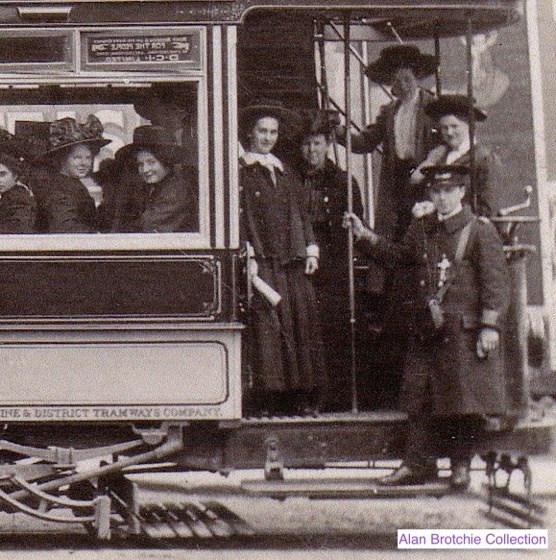
A conductor — taken shortly after opening — in a long, double-breasted greatcoat, seemingly devoid of insignia. His cap bears only a script-lettering grade badge.
Script-lettering grade cap badges of the pattern issued by the D&DTCo — it is currently unclear whether the company issued these in brass or nickel. Author's Collection.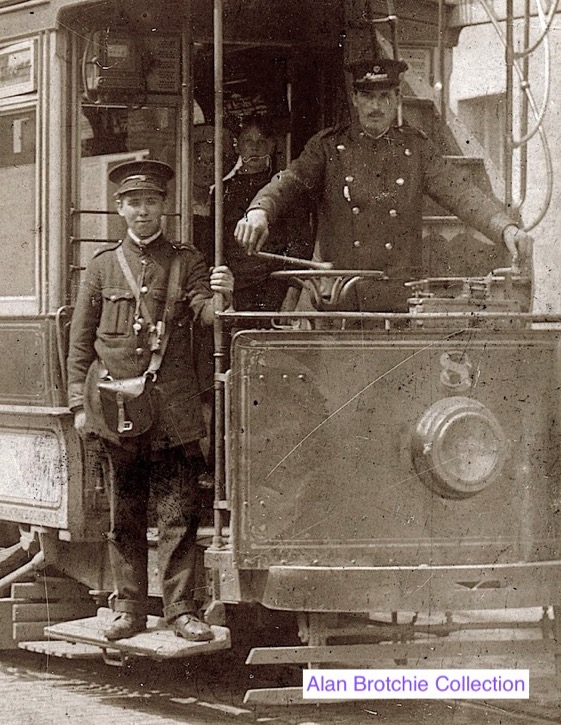
A conductor and a motorman with Tramcar No 8 on a Lochore service — photo undated, but probably taken during the Great War given the age of the conductor.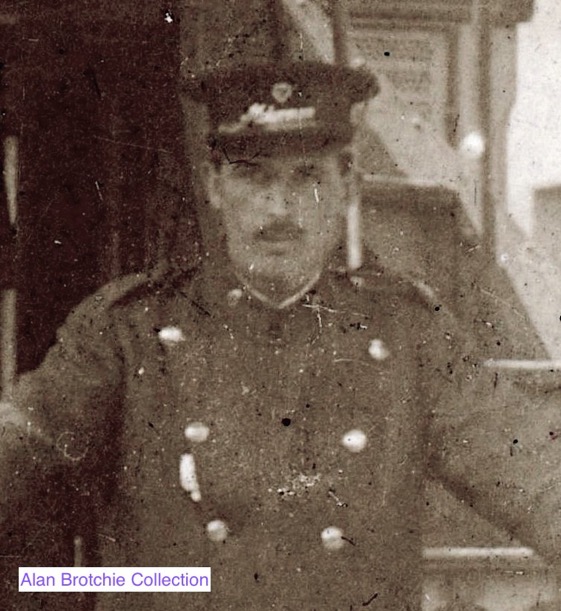
An enlargement of the above photograph showing the motorman's script-lettering grade badge, along with a small shield-shaped badge of unknown pattern, possibly military in origin.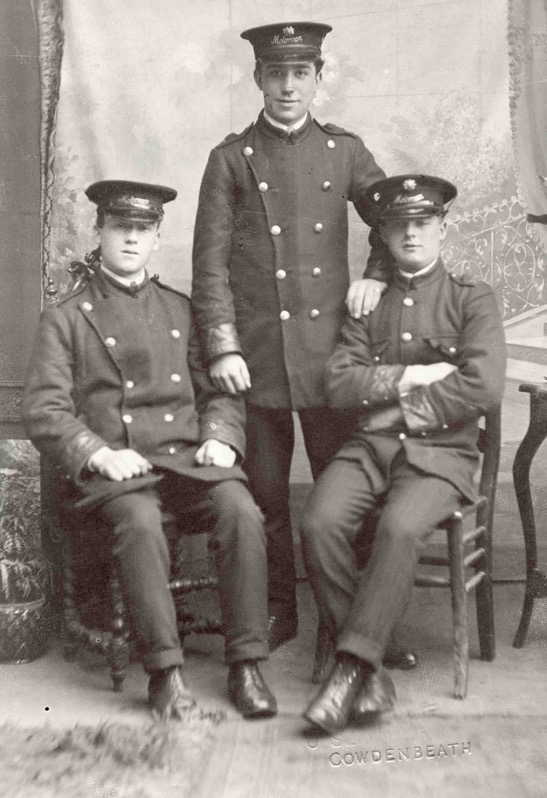
A portrait of three D&DTCo motormen, taken at a studio in Cowdenbeath. Although undated, it seems likely that it was taken around the start of the Great War, as two of the men are wearing regimental badges above their grade badges. The individual seated to the right is actually wearing a conductor's jacket, but with a 'Motorman' cap badge, suggesting that he may have been promoted, perhaps to fill places already vacated by men who had enlisted. Author's Collection.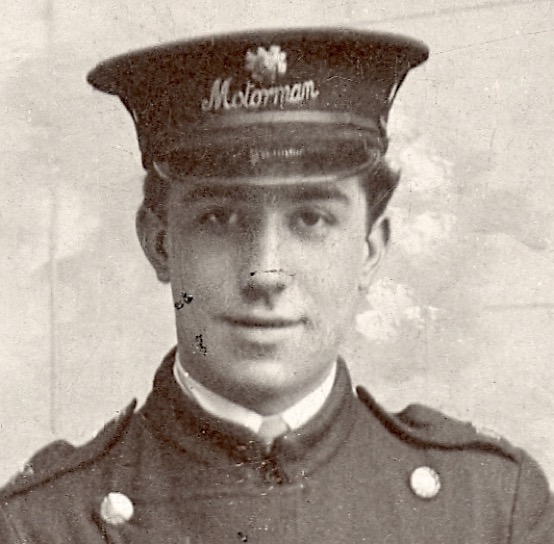
An enlargement of the above photograph showing one of the men. The jacket bears plain, scalloped rim buttons, whilst the epaulettes bear an employee number. The regimental badge above the grade badge is for the Scots Guards. Alan Brotchie suggests that the photo may have been taken as a memento after the three of them had signed up.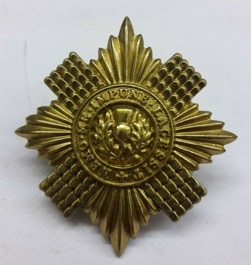
An example of a Great War Scots Guards cap badge.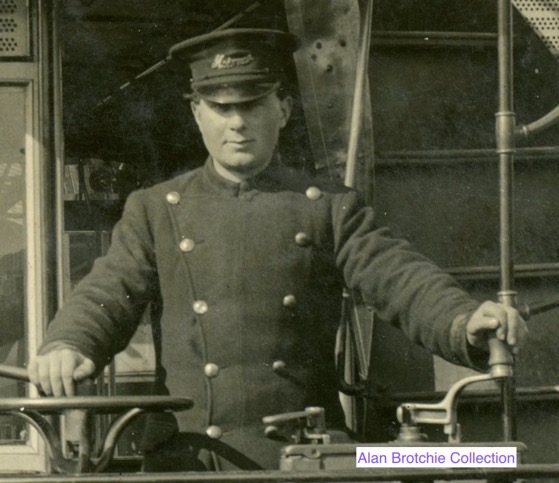
An enlargement of the photograph of Tramcar No 22 below, showing the motorman — photo undated, but probably taken during the Great War or shortly afterwards. Magnification of this photo suggests that the buttons were plain with a scalloped rim, similar to those worn by nearby Kirkcaldy and Wemyss (the latter from 1912 onwards).
Senior staff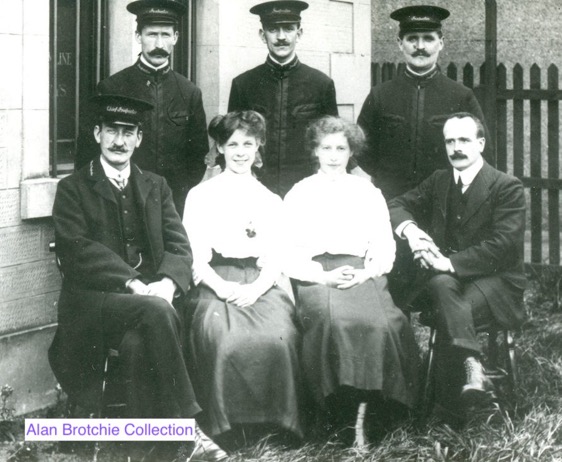
A line-up of senior staff — photo undated, but probably taken not long after the opening (1909). Back row, left to right: Inspector Brown, Inspector Leitch and Inspector Duncan. Front row: Chief Inspector Menzies, two clerkesses, and the manager, Mr Shepherd.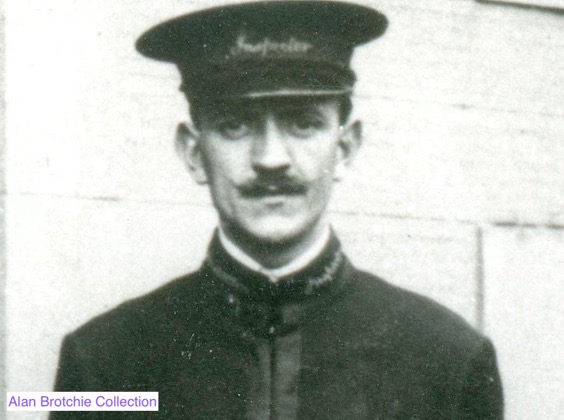
An enlargement of the above photograph showing Inspector Leitch. The uniform is a standard style for this grade, used by numerous tramway operators throughout the country.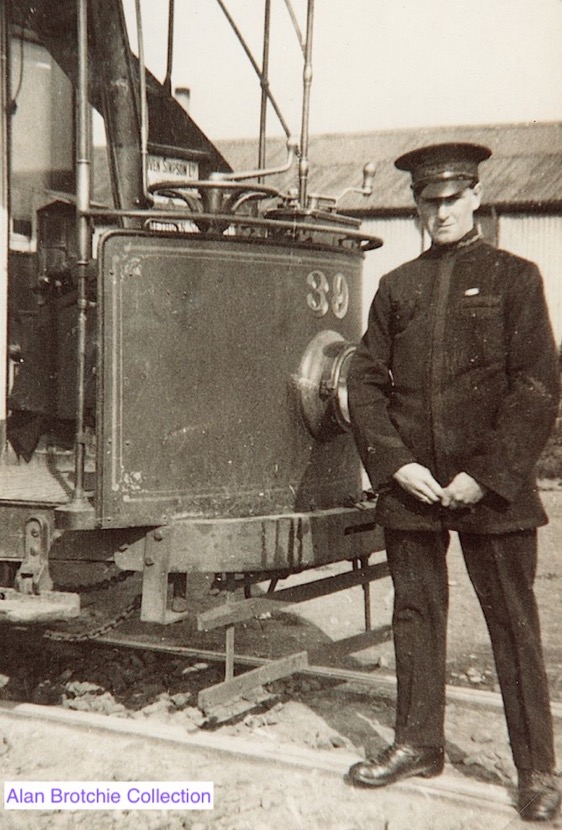
Inspector Edward McKenna with Tramcar No 39 at St Leonard's Street depot in 1924. The uniform is identical to that seen in the earlier photograph above. Note the chevrons on the lower sleeves.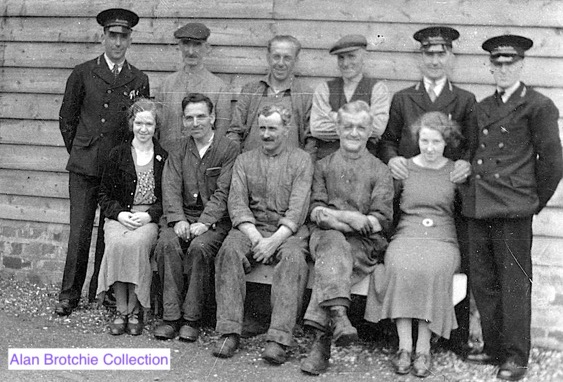
A shot with three inspectors and what appear to be depot staff — photo undated, but probably taken in the 1930s. The inspectors' uniforms still bear embroidered grades, but the jacket is now a more modern double-breasted design with lapels.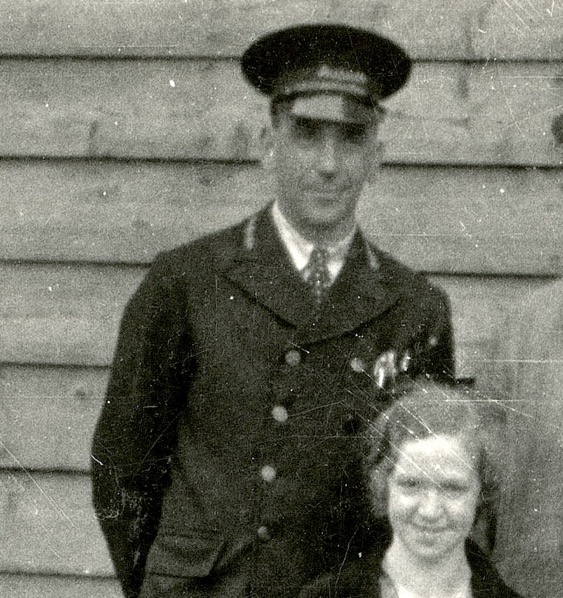
An enlargement of the above photograph showing one of the new style jackets.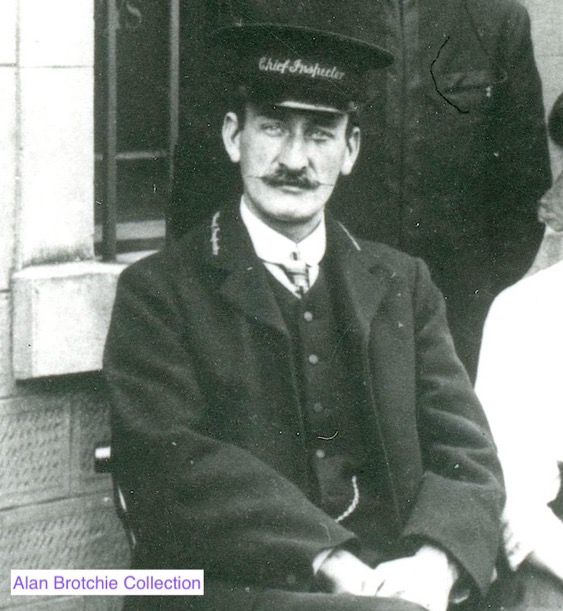
Another blow-up of the first senior staff photo above, this time of Chief Inspector Menzies.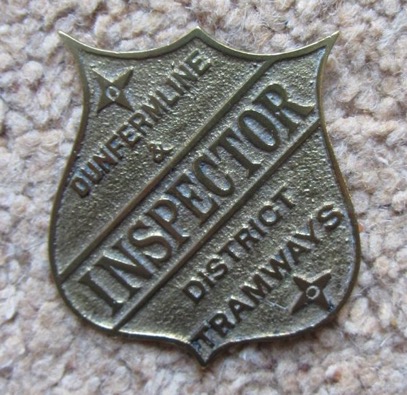
A Dunfermline and District Tramways Inspector's cap badge — brass. This badge is somewhat of a mystery, firstly due to its curious American styling, and secondly, because there is no sign (in the photographic record) of it ever being worn. Alan Brotchie Collection.
Female staff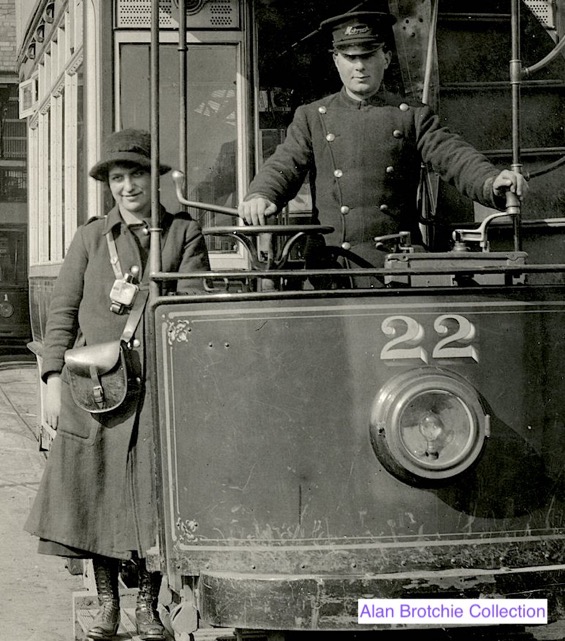
A conductress and a motorman with Tramcar No 22 at Cowdenbeath Depot — photo undated, but probably taken during the Great War or shortly afterwards, given that the destination box is still above the top rail (these were moved to below the canopy in the early 1920s). The conductress is probably wearing a company-issued topcoat, but with her own hat.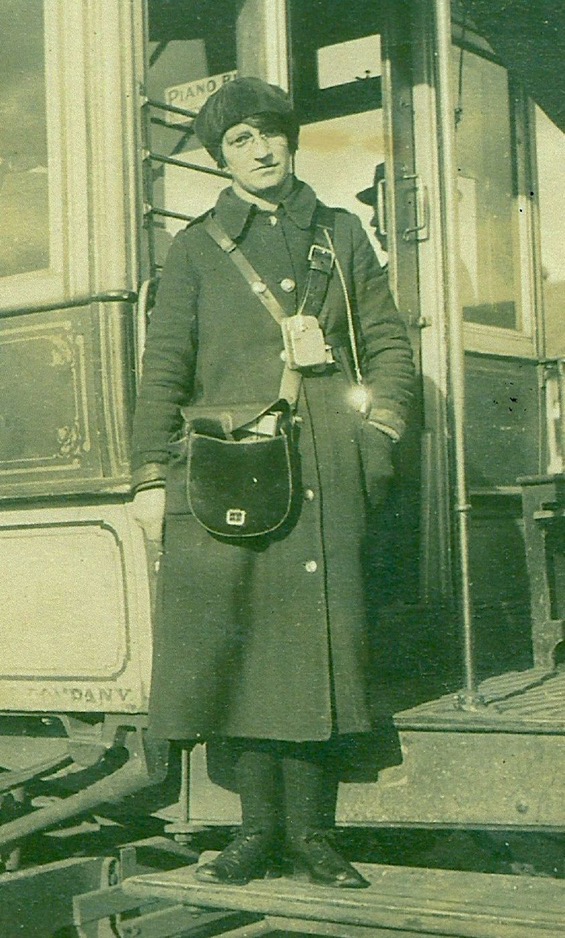
A D&DTCo conductress stands on the footstep of an unidentified tram — photo undated, but probably taken during or shortly after the Great War. She is wearing a long single-breasted topcoat with metal buttons, which is otherwise completely devoid of insignia. Her hat appears to be an informal brimless bonnet, again without a badge of any kind. Photo courtesy of Old Fife Buses.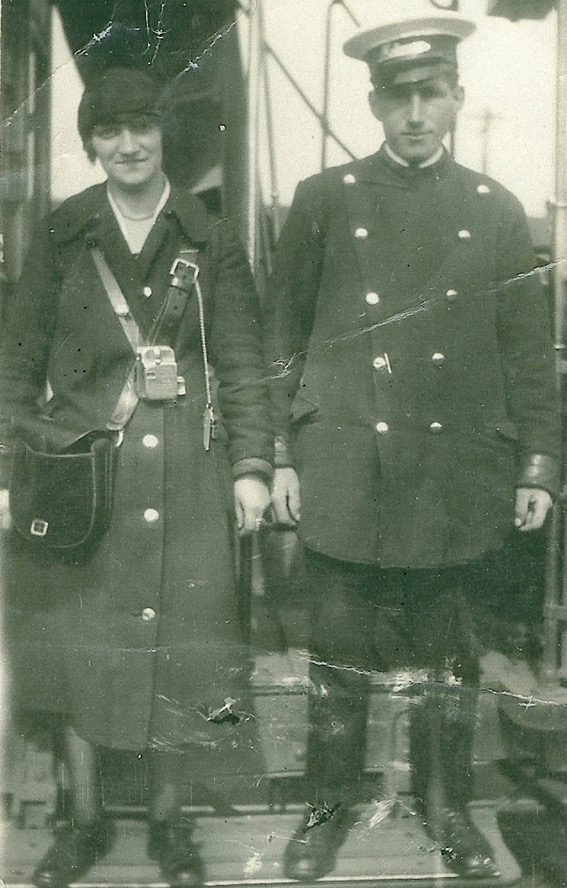
Another shot of a conductress, very probably the same lady pictured in the previous image, but this time with her motorman. Photo courtesy of Old Fife Buses.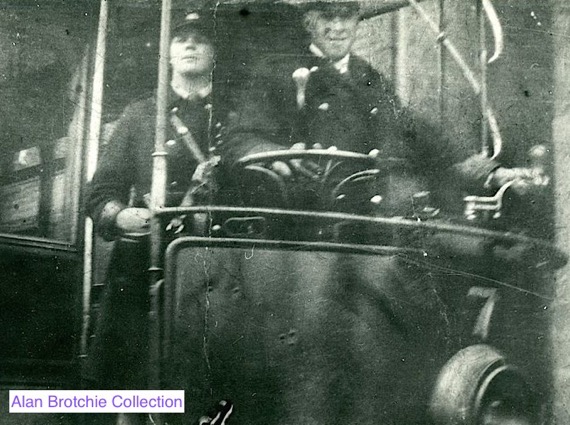
Another photograph of a conductress — date uncertain — but one in which a double-breasted topcoat is being worn, along with a peaked cap bearing a cap badge, possibly a regimental sweetheart badge. 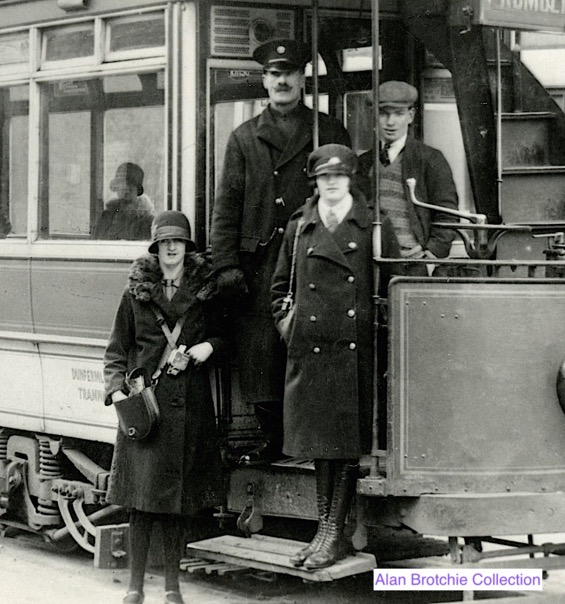
A couple of conductresses and a motorman pose for the cameraman on the platform of Rumblingwell-bound Tramcar No 12 — photo undated, but probably taken in the late 1920s (the destination box is below the canopy). The lady on the right is wearing a uniform with a motor cap bearing a badge of some description, whereas the lady on the left appears to be in informal attire.